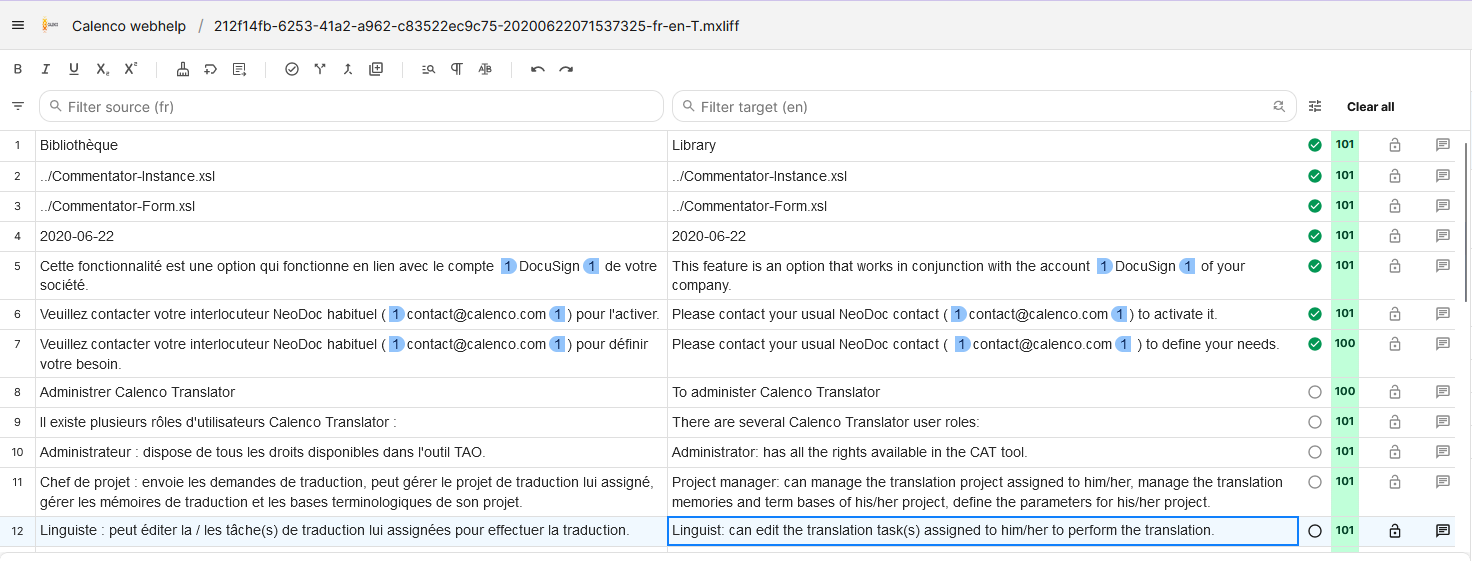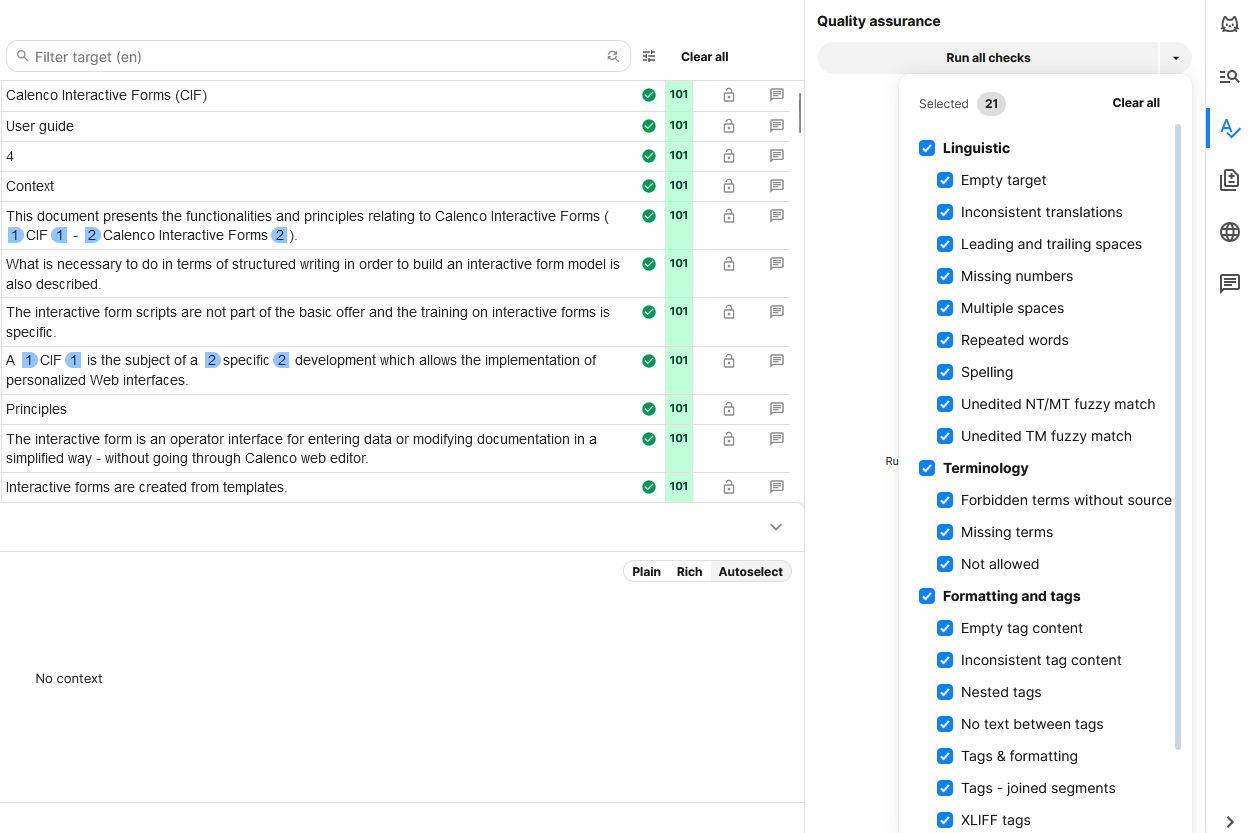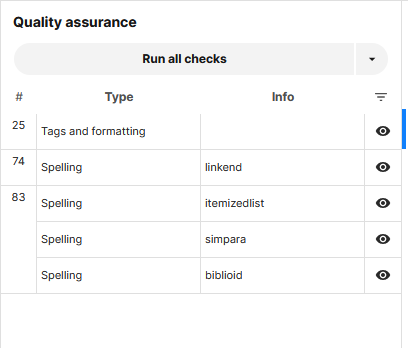3. Perform a translation task in Phrase

Translation tasks will be assigned to you by the translation project manager from Calenco directly. Each file of a translation request (cf. To ask for translation) is a task. |
3.1. Manage the status of a translation job
Each translation job can have different statuses as the translation project progresses. The status of a job is visible in the Status column. The modification of the status is carried out:
either via the pencil that appears to the left of the job number when hovering over the job with the cursor;
or via the icon above the job list (select the job to activate the icon).
The most frequently used statuses in a project are:
New: job newly created via a translation request from Calenco;
Accepted: job for which the translator has started work;
Completed: job translated, revised and validated.
Switching the job to Completed status automatically sends it back to Calenco.
The translation job can be validated several times and taken into account on Calenco, in the event that it is necessary to improve the translation of the same version of the document. For the changes to be taken into account on Calenco:
Return the task to the Accepted status.
Make the necessary changes in the editor To edit a translation task.
Validate the task with status Completed.
3.2. To pre-translate a translation task
Select the task to perform by checking the corresponding box in the leftmost column.
Click on to automatically translate segments thanks to the one of the translation memories.
Keep the default settings in the new window that just opened and click on Pre-translate to start the pre-translation.
Following the pre-translation, the percentage of confirmation of the task changes. If not, then you have no translation memory.
If the confirmation percentage has not reached 100%, click on the name of the task in the File column to open the translation task editor.
3.3. To edit a translation task
To open the Translation Editor, click the name of the task in the column File. A new tab is opened:

In this window, you will find all of your translation segments in the source language and in the translation language.
If you have performed a pre-translation, the translated segments appear in the column without being validated. |
To validate pre-translated segments
Look at the translation segments that are to be validated, they will be marked with an empty circle in the column to the right of the column .
Modify the segments whose translation does not match by editing the fields in the column .
Validate the segments by left clicking on the empty circle associated with them; it then turns into a green check mark.
If you do not validate all the segments, the confirmation percentage of the task will not reach 100% and the translations of the non-validated segments will not be sent to your workspace in Calenco. |
3.4. Assess the quality of the translation
Once all the segments are translated and validated with the green tick, it is recommended to carry out quality assurance of the translation, before passing the task to Completed status.
In the vertical menu to the right of the editor interface, click
 .
.A pane opens to the right of the editor interface.
Select items to scan for quality assurance.

Click to display the results in the pane.

Click on the message to go to the relevant line.
Types of messages and their meaning:
Leading and trailing spaces: extra space(s) at the start or end of the segment;
Multiple spaces: extra space(s) between words;
Spelling: spelling problem;
Unedited TM (NT/MT) fuzzy match: partial match problem with the translation memory (between the non-translatable element and the translation engine);
Tags and formatting: the number of tags in the target language does not match the number of tags in the source language, or the text is missing between two tags in the target language.

Correcting issues with message “tags and formatting” is essential to ensure translated files are returned to Calenco. |
Use the Fn+F8 keyboard shortcut to insert a tag. |
3.5. Managing translation memories
If one does not already exist, the translation memory is automatically generated when a new translation is requested.
The new memory is created for the relevant topic in the CAT tool. The memory name is constructed as following: [nom_client] [SOURCE LANGUAGE CODE]. Example: Company AB FR.
The corresponding translation memory in the CAT tool is automatically allocated to the translation project when it arrives from Calenco.
Changing the name of the translation memory, or replacing it with a different translation memory, invalidates the operation of the connector. If necessary, you need to retrieve the last element of the url link of the new TM (example: https://cloud.memsource.com/web/transMemory/show/HhBuqdqzF5a10Ag9yIOCpf) and forward it to NeoDoc. |
3.5.1. Machine translation (MT) engines in Phrase
The Phrase Translate module uses AI to automatically select the optimal MT engine for your translation jobs, based on each job's domain and language pair.
This feature is an additional option. Please contact your usual NeodDoc contact ( |